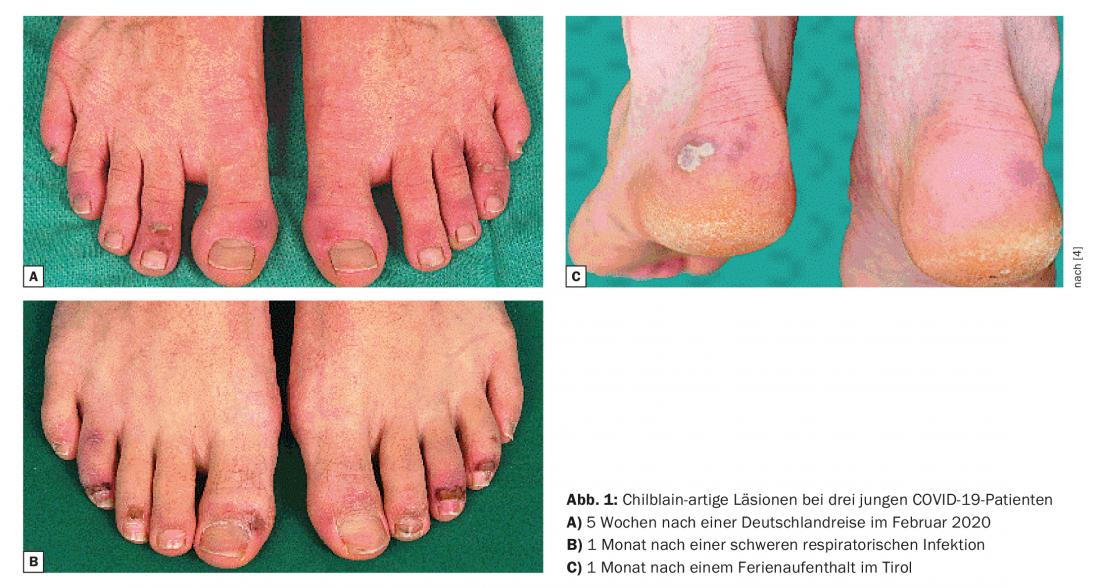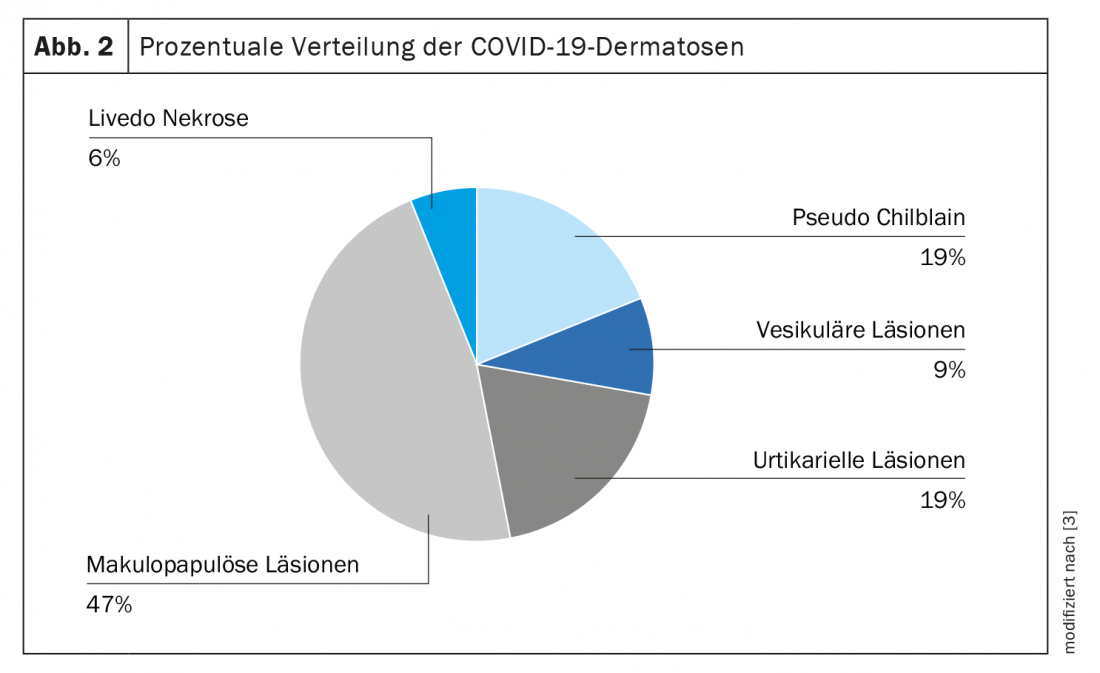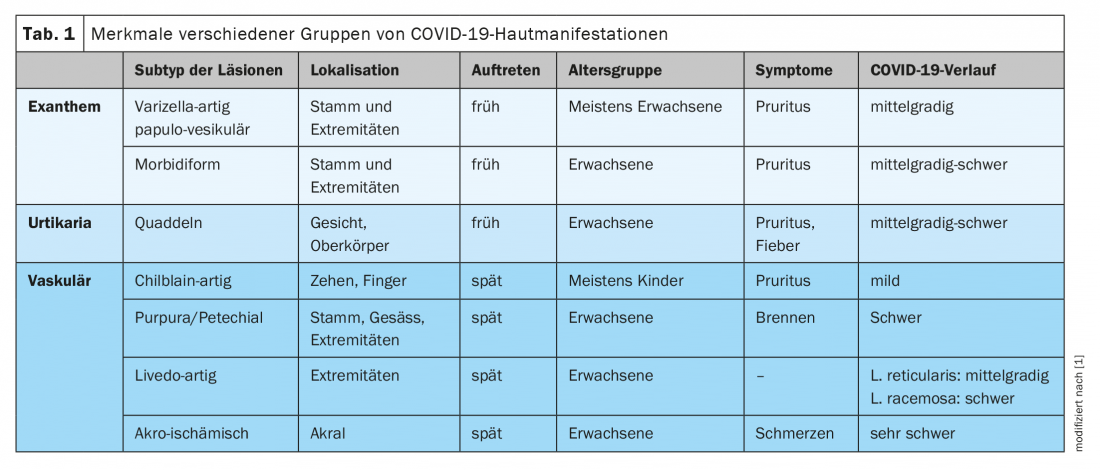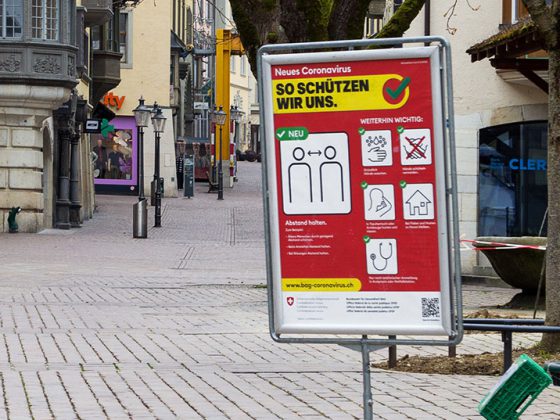In light of recent events, the focus of the 5th Post-EADV Meeting was on implications of pandemic coronary disease for dermatologists. One of the presentations was dedicated to the topic of COVID-19-associated skin lesions. Current findings and case reports were presented on dermatoses that have been observed and documented to date in the setting of SARS-CoV-2 infection.
Christin Pelzer, MD, assistant physician at the Department of Dermatology of the Cantonal Hospital St. Gallen, gave an overview of the current state of knowledge of COVID-19 dermatoses [1] in her presentation. The speaker summarized five important messages relevant to practice as follows:
- Urticaria with fever may be an early symptom of SARS-CoV-2 infection (-> low-threshold testing)
- Papulovesicular skin lesions may be an early sign of SARS-CoV-2 infection
- Chilblain-like lesions as well as erythema multiforme-like skin lesions are more common in children and young adults with absent or mild symptoms(◊ low-threshold testing for SARS-CoV-2).
- Ischemic skin lesions such as livedo racemosa, purpura/vasculitis, necrosis, or maculopapular exanthema in adults are associated with a severe COVID-19 course
- Men with androgenetic alopecia appear at risk for a severe course.

As with other manifestations of COVID-19 diseases, a large number of scientific publications, including some secondary analyses, have already been published on dermatological manifestations of the disease. In a recently published review, skin manifestations occurring in association with SARS-CoV-2 infection are divided into exanthematous inflammatory dermatoses and vasculopathic/vasculitic dermatoses [2]. The former are further differentiated into urticarial, maculopapular, or papulovesicular exanthema. The vasculopathic subgroup is divided into chilblain-like (Fig. 1), livedo-reticular, or purpura vasculitic lesions. The percentage frequencies of the different COVID-19 skin manifestations according to a prospective study in Spain (n=375) are shown in Figure 2.

Exanthematous inflammatory dermatoses
1. urticarial exanthema: this subgroup of skin manifestations accounts for about 10-20% of COVID-19 dermatoses, depending on the literature, and usually occurs concurrently with the classic corona symptoms such as cough, fever, etc. “If you have a patient who has urticaria and fever, keep in mind that this combination may be a manifestation of early SARS-CoV-2 infection. That means you would recommend testing,” the speaker explained. This dermatosis is associated with moderate to severe COVID-19 progression, similar to maculopapular/macular exanthema.
2. maculopapular/macular exanthema: this is the largest group of COVID-19 dermatoses in percentage terms. These may occur at the onset or during the course of COVID-19 disease. Most often adults are affected and there is no palmoplantar or mucosal involvement, but there is severe pruritus. In the rare cases in which children are affected by maculopapular/macular exanthema, hands or feet may also be affected.
Erythema multiforme- or pytiriasis rosea-like skin lesions or perifollicular morbidiform exanthema can also be assigned to this subgroup. There is a positive correlation between morbidiform exanthema and hospitalization for pneumonia, Dr. Pelzer said. The erythema multiforme-like skin lesions are more common in children and are usually associated with a mild COVID-19 course, the speaker explained.
3. papulovesicular exanthema: these skin manifestations occur mainly in patients around 60 years of age, more likely before the classic symptoms of SARS-CoV-2 infection or within the first 3 days. Skin manifestations persisted for approximately 1.5 weeks. The body trunk is mainly affected and the lesions tend to be monomorphic with little or no itching. Unlike chickenpox, which is more polymorphic, highly itchy and also highly disseminated, including facial involvement. “Healing of COVID-19 vesicular dermatoses is generally without scarring and associated with intermediate severity of COVID-19,” Dr. Pelzer added.
Vasculopathic/vasculitic dermatoses
1. chilblain-like skin lesions: Chilblain-like or pseudo-chilblain-like lesions (Fig. 1) are sometimes referred to as “COVID toes.” The speaker points out that not only toes but also fingers can be affected and other acral regions, such as the ears. Most often, these skin manifestations occur in the setting of mild COVID-19 courses, relatively common in children or young adults. The lesions may hurt, burn or itch. Without therapy, healing can be expected within two weeks.
2. livedo racemosa/reticularis-like skin lesions: The livedo racemosa/reticularis-like skin lesions in COVID-19 are rare but associated with severe disease progression. In a Spanish study of 375 patients summarizing various vasculopathic/vasculitic skin lesions, a 10% mortality was found in this group. Acrocyanosis, blistering, dry gangrene, or necrosis are also associated with severe COVID-19 progression, she said. Livedo racemosa was a hallmark that severe coagulopathy had occurred, he said. In contrast, reticularis-like skin lesions tend to be associated with mild, transient courses, usually without thromboembolic complications.
3. purpura and vasculitic pattern: this group of skin manifestations occurs frequently in elderly COVID-19 patients and is associated with a high mortality rate. “In severe COVID-19, hypercoagulation and disseminated intravascular coagulation can occur, which is called DIC,” Dr. Pelzer explained.
Literature:
- Pelzer C: COVID-19 dermatoses. Christin Pelzer, MD. Post-EADV Meeting, Dec. 10, 2020.
- Genovese G, et al: Skin Manifestations Associated with COVID-19: Current Knowledge and Future Perspectives. Dermatology 2021; 237: 1-12.
- Galván Casas C, et al: Classification of the cutaneous manifestations of COVID-19: a rapid prospective nationwide consensus study in Spain with 375 cases. BJD 2020; 183(1): 71-77.
- Aschoff R, et al: Type I Interferon Signature in Chilblain-Like Lesions Associated with the COVID-19 Pandemic. Dermatopathology 2020, 7(3), 57-63.
DERMATOLOGIE PRAXIS 2021; 31(1): 15-16 (published 2/23/21, ahead of print).












